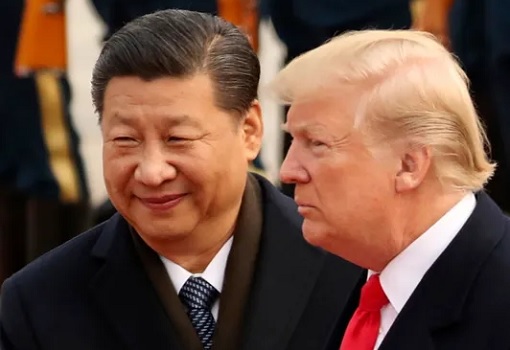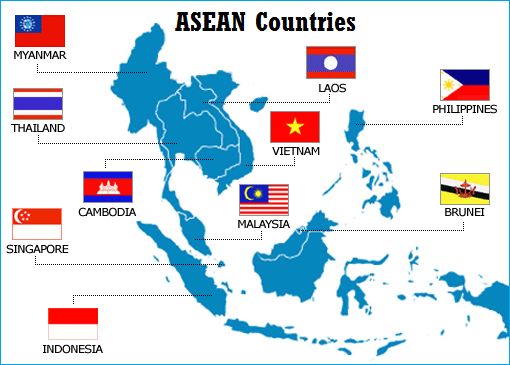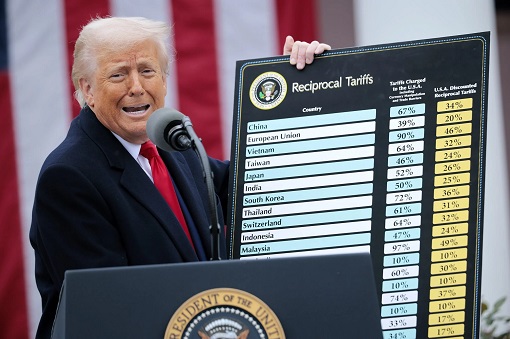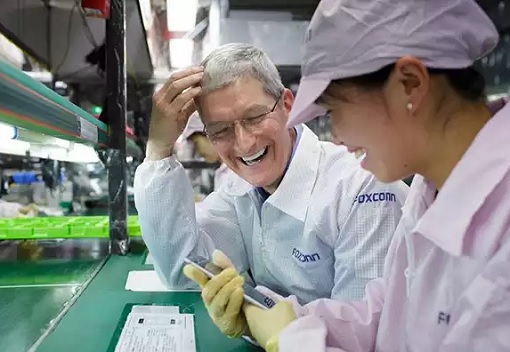
Beijing Raises Tariffs To 125% – American Goods No Longer Marketable In China
April 11th, 2025 by financetwitter
In all three rounds of tax hikes – from 34% to 84%, and then to 125% – since Donald Trump started his tariff war on China last Wednesday (April 2), the U.S. president actually thought he could win easily. After all, Beijing was weak during Trump’s first term eight years ago, unwilling to go full force and had agreed to buy more American agricultural products to reduce trade deficit with the U.S.
This round, to the shocking Trump administration, China has chosen to retaliate at each turn – matching all of the tariff hikes. On Friday (April 11), the same day President Xi Jinping was hosting Spanish Prime Minister Pedro Sanchez in Beijing, the Middle Kingdom said it would raise its tariff on U.S. goods from 84% to 125% to match an escalation by the White House.
Essentially, both the U.S. and China are at each other’s throat, refusing to back down. Overall, tariffs imposed on China by Trump in his second term add up to 145% due to two rounds of 10% tariff each imposed earlier this year for allegation of China’s role in the flow of illegal fentanyl drug into the U.S. But it doesn’t matter whether it’s 125% or 145% tariffs.

The latest Chinese move, to take effect Saturday (April 12), would be its final retaliation in terms of tariff hikes as it’s no longer interested in wasting time and will ignore Trump’s further increases. “Even if the U.S. continues to impose higher tariffs, it would be economically meaningless and would become a joke in the history of the world economy,” – said Beijing.
Indeed, with American products suddenly becomes more than twice pricier, the 1.4-billion Chinese populations would avoid them like a plague. Hence, it’s meaningless to continue to entertain the egoistic American president. Even in the U.S., the consumers would be having trouble paying for Trump’s 145% tariff on Chinese products. The last time the U.S. increased tariffs to this level in 1930, it made the 1929 Great Depression much worse.
So, China prefers to watch with popcorn the damage that Mr Trump has just inflicted on the American consumers. It does not make any difference even if the White House raises it to 400%, as suggested by pro-Trump morons like Canadian businessman Kevin O’Leary, because 125% is already the tipping point where imports are no longer marketable.

Although China exports much more to the United States than it imports, China is the “third-largest buyer of U.S. goods”, purchasing about US$143.5 billion of products last year (trade in goods between both nations hit US$582 billion in 2024). Beijing is now looking to target the service trade, where the U.S. enjoyed US$26.5 billion surplus, as well as warning its citizens from travelling and studying in the U.S., and to reduce imports of American movies.
Astonishingly, China saw how Trump blinked when he had to make a humiliating U-turn – announcing a 90-day tariff pause on “reciprocal tariffs” with dozens of countries after the tariff war wrecked havoc on both stock market and bond market. Trump told reporters at the White House on Thursday that he thought the U.S. could make a deal with China and said he respected Xi Jinping.
However, Chinese President Xi Jin Ping told Spanish Prime Minister Pedro Sanchez on Friday that China and the European Union should “jointly oppose unilateral acts of bullying,” in a clear swipe at Trump’s tariff policies. Instead of picking fights with the entire world, China has signed two agricultural trades with Spain covering pork and cherries in a strategic move to reward Spain and punish American pork.

Sanchez, who is making his third trip to the country in two years, said Spain was in favour of “more balanced relations between the European Union and China, of finding negotiated solutions to our differences, which we have, and of greater cooperation in areas of common interest.” As expected, Washington was not happy with the Spanish PM’s pursue of a closer trade ties with China.
Spain – the eurozone’s fourth-largest economy and a leader in growth – has in recent years been less hostile toward China than other EU countries. While Spain is a major supplier of pork to China, providing about 20% of China’s imports, Chinese electric battery company CATL has announced a 4.1 billion euro (US$4.5 billion) joint venture with automaker Stellantis to build a battery factory in northern Spain.
President Xi does not need to win over the entire European Union to soften the impact of Trump’s tariffs. He just needs to convince some that China is a reliable trading partner in a time of economic uncertainties triggered by the U.S. The Chinese leader will begin a three-nation tour of Southeast Asia next week to consolidate ties with some of China’s closest neighbours like Cambodia, Vietnam and Malaysia.

China and Vietnam are expected to sign about 40 agreements during Xi’s visit from April 14 to 15. Malaysia Prime Minister Anwar Ibrahim, who is looking forward very much to meeting Xi, will show the strong bonds – “flowing water cannot be severed” – between Malaysia and China. The trip will also feature President Xi and his “ironclad friends” from Cambodia.
Sure, many countries will scramble to negotiate with the U.S. president, who gloats that “they were trying to kiss my ass”. But at the same time, thanks to Trump’s 90-day pause, they will also – silently without provoking the U.S. – pivot to China to counter Trump tariffs. The White House must be hallucinating if it thinks the tariff war could isolate China, the world’s second largest economy.
As turbulence hits stocks, bonds and the U.S. dollar, one asset is soaring – GOLD. On Friday it hit another record, trading above US$3,200 per troy ounce. Gold is now considered a haven asset, even more secure than American Treasury, which was being dumped like junk papers. And guess which country has been buying gold like crazy for the past few years since Russian foreign reserves were illegally seized.

Hilariously, the U.S. Treasury bonds have been so fragile that JPMorgan Chase’s chief executive, Jamie Dimon, said in a media briefing that his bank was concerned and looking at the bond market “every minute.” But that was not the only problem that has started hitting America. A survey revealed that U.S. consumer fears about recession could see prices surge to 6.7% – a level of pessimism last seen in the brutal 1980s inflation.
Tesla, already losing market share to Chinese electric vehicle maker BYD, has stopped accepting new orders in China for two car models that it imports from a factory in the U.S., after Beijing imposed steep tariffs on American imports. Tesla boss, Elon Musk, has labelled Trump’s trade advisor Peter Navarro as a “moron” who is “dumber than a sack of bricks,” before later sarcastically apologizing to bricks.
Like it or not, the U.S. needs China more than China needs America. Take manufacturing for example. Donald Trump likes to scam his supporters that the tariff war would restore American manufacturing – a fantasy that is both unachievable and unrealistic. It’s always a wet dream to think it’s possible to transfer China’s world factory back to the U.S. with a snap of a finger.

There’s a reason why manufacturing is a mere 10% of the U.S. GDP and has been steadily declining for years. The reason is simple – it’s cheaper to manufacture goods overseas, where labour is less expensive. Additionally, automation has steadily decreased the number of American workers needed to produce goods. Even if the White House could forcefully reshore manufacturing back to the U.S., it would hard to find workers.
When President Barack Obama asked the late Apple CEO Steve Jobs about making an iPhone in the U.S., Mr Jobs bluntly responded – “Those jobs aren’t coming back”. Ask any analysts today and all of them will tell you that the idea of an American-made iPhone is impossible at worst and highly expensive at best. And it’s not hard to understand why.
Bank of America Securities analyst Wamsi Mohan said that the iPhone 16 Pro, which is currently priced at US$1,199, could increase 25% based on labour costs alone. That would make it a roughly US$1,500 device. At the moment, Apple makes more than 80% of its products in China. Thanks to Trump’s tariffs, those products now receive a 145% tax when they’re imported into the U.S.

Even if Apple willingly spent heavily to get Foxconn or another partner to build some iPhones in the U.S, it would take years to construct the plants and install the machinery, and there’s no guarantee that U.S. trade policy might not change yet again in a way to make the factory less useful. The biggest issue with America’s iPhone is that the U.S. doesn’t have the same workforce as China – allowing Apple to pump out 200 million iPhones every year.
Even if Trump could hire tens of thousands of workers and replicate the massive campuses include dorms and shuttles, Chinese workers get paid far less than American workers. The hourly wage during the iPhone 16 surge was 26 yuan (US$3.63), with a signing bonus of 7,500 yuan (about US$1,000). In comparison, the minimum wage in California is US$16.50 per hour – more than 4 times higher.
Crucially, today, the U.S. accounts for about 15% of China’s total exports, down from almost 20% in 2017. Despite Trump’s 145% tariff, the U.S. still needs to import Chinese goods, but the same cannot be said about China importing American goods at 125% tariff. This is why President Xi said “China is not afraid” as it is self-reliant in facing the Tariff War.

Essentially, both the U.S. and China are at each other’s throat, refusing to back down. Overall, tariffs imposed on China by Trump in his second term add up to 145% due to two rounds of 10% tariff each imposed earlier this year for allegation of China’s role in the flow of illegal fentanyl drug into the U.S. But it doesn’t matter whether it’s 125% or 145% tariffs.

The latest Chinese move, to take effect Saturday (April 12), would be its final retaliation in terms of tariff hikes as it’s no longer interested in wasting time and will ignore Trump’s further increases. “Even if the U.S. continues to impose higher tariffs, it would be economically meaningless and would become a joke in the history of the world economy,” – said Beijing.
Indeed, with American products suddenly becomes more than twice pricier, the 1.4-billion Chinese populations would avoid them like a plague. Hence, it’s meaningless to continue to entertain the egoistic American president. Even in the U.S., the consumers would be having trouble paying for Trump’s 145% tariff on Chinese products. The last time the U.S. increased tariffs to this level in 1930, it made the 1929 Great Depression much worse.
So, China prefers to watch with popcorn the damage that Mr Trump has just inflicted on the American consumers. It does not make any difference even if the White House raises it to 400%, as suggested by pro-Trump morons like Canadian businessman Kevin O’Leary, because 125% is already the tipping point where imports are no longer marketable.

Although China exports much more to the United States than it imports, China is the “third-largest buyer of U.S. goods”, purchasing about US$143.5 billion of products last year (trade in goods between both nations hit US$582 billion in 2024). Beijing is now looking to target the service trade, where the U.S. enjoyed US$26.5 billion surplus, as well as warning its citizens from travelling and studying in the U.S., and to reduce imports of American movies.
Astonishingly, China saw how Trump blinked when he had to make a humiliating U-turn – announcing a 90-day tariff pause on “reciprocal tariffs” with dozens of countries after the tariff war wrecked havoc on both stock market and bond market. Trump told reporters at the White House on Thursday that he thought the U.S. could make a deal with China and said he respected Xi Jinping.
However, Chinese President Xi Jin Ping told Spanish Prime Minister Pedro Sanchez on Friday that China and the European Union should “jointly oppose unilateral acts of bullying,” in a clear swipe at Trump’s tariff policies. Instead of picking fights with the entire world, China has signed two agricultural trades with Spain covering pork and cherries in a strategic move to reward Spain and punish American pork.

Sanchez, who is making his third trip to the country in two years, said Spain was in favour of “more balanced relations between the European Union and China, of finding negotiated solutions to our differences, which we have, and of greater cooperation in areas of common interest.” As expected, Washington was not happy with the Spanish PM’s pursue of a closer trade ties with China.
Spain – the eurozone’s fourth-largest economy and a leader in growth – has in recent years been less hostile toward China than other EU countries. While Spain is a major supplier of pork to China, providing about 20% of China’s imports, Chinese electric battery company CATL has announced a 4.1 billion euro (US$4.5 billion) joint venture with automaker Stellantis to build a battery factory in northern Spain.
President Xi does not need to win over the entire European Union to soften the impact of Trump’s tariffs. He just needs to convince some that China is a reliable trading partner in a time of economic uncertainties triggered by the U.S. The Chinese leader will begin a three-nation tour of Southeast Asia next week to consolidate ties with some of China’s closest neighbours like Cambodia, Vietnam and Malaysia.

China and Vietnam are expected to sign about 40 agreements during Xi’s visit from April 14 to 15. Malaysia Prime Minister Anwar Ibrahim, who is looking forward very much to meeting Xi, will show the strong bonds – “flowing water cannot be severed” – between Malaysia and China. The trip will also feature President Xi and his “ironclad friends” from Cambodia.
Sure, many countries will scramble to negotiate with the U.S. president, who gloats that “they were trying to kiss my ass”. But at the same time, thanks to Trump’s 90-day pause, they will also – silently without provoking the U.S. – pivot to China to counter Trump tariffs. The White House must be hallucinating if it thinks the tariff war could isolate China, the world’s second largest economy.
As turbulence hits stocks, bonds and the U.S. dollar, one asset is soaring – GOLD. On Friday it hit another record, trading above US$3,200 per troy ounce. Gold is now considered a haven asset, even more secure than American Treasury, which was being dumped like junk papers. And guess which country has been buying gold like crazy for the past few years since Russian foreign reserves were illegally seized.

Hilariously, the U.S. Treasury bonds have been so fragile that JPMorgan Chase’s chief executive, Jamie Dimon, said in a media briefing that his bank was concerned and looking at the bond market “every minute.” But that was not the only problem that has started hitting America. A survey revealed that U.S. consumer fears about recession could see prices surge to 6.7% – a level of pessimism last seen in the brutal 1980s inflation.
Tesla, already losing market share to Chinese electric vehicle maker BYD, has stopped accepting new orders in China for two car models that it imports from a factory in the U.S., after Beijing imposed steep tariffs on American imports. Tesla boss, Elon Musk, has labelled Trump’s trade advisor Peter Navarro as a “moron” who is “dumber than a sack of bricks,” before later sarcastically apologizing to bricks.
Like it or not, the U.S. needs China more than China needs America. Take manufacturing for example. Donald Trump likes to scam his supporters that the tariff war would restore American manufacturing – a fantasy that is both unachievable and unrealistic. It’s always a wet dream to think it’s possible to transfer China’s world factory back to the U.S. with a snap of a finger.

There’s a reason why manufacturing is a mere 10% of the U.S. GDP and has been steadily declining for years. The reason is simple – it’s cheaper to manufacture goods overseas, where labour is less expensive. Additionally, automation has steadily decreased the number of American workers needed to produce goods. Even if the White House could forcefully reshore manufacturing back to the U.S., it would hard to find workers.
When President Barack Obama asked the late Apple CEO Steve Jobs about making an iPhone in the U.S., Mr Jobs bluntly responded – “Those jobs aren’t coming back”. Ask any analysts today and all of them will tell you that the idea of an American-made iPhone is impossible at worst and highly expensive at best. And it’s not hard to understand why.
Bank of America Securities analyst Wamsi Mohan said that the iPhone 16 Pro, which is currently priced at US$1,199, could increase 25% based on labour costs alone. That would make it a roughly US$1,500 device. At the moment, Apple makes more than 80% of its products in China. Thanks to Trump’s tariffs, those products now receive a 145% tax when they’re imported into the U.S.

Even if Apple willingly spent heavily to get Foxconn or another partner to build some iPhones in the U.S, it would take years to construct the plants and install the machinery, and there’s no guarantee that U.S. trade policy might not change yet again in a way to make the factory less useful. The biggest issue with America’s iPhone is that the U.S. doesn’t have the same workforce as China – allowing Apple to pump out 200 million iPhones every year.
Even if Trump could hire tens of thousands of workers and replicate the massive campuses include dorms and shuttles, Chinese workers get paid far less than American workers. The hourly wage during the iPhone 16 surge was 26 yuan (US$3.63), with a signing bonus of 7,500 yuan (about US$1,000). In comparison, the minimum wage in California is US$16.50 per hour – more than 4 times higher.
Crucially, today, the U.S. accounts for about 15% of China’s total exports, down from almost 20% in 2017. Despite Trump’s 145% tariff, the U.S. still needs to import Chinese goods, but the same cannot be said about China importing American goods at 125% tariff. This is why President Xi said “China is not afraid” as it is self-reliant in facing the Tariff War.

"Beijing was weak during Trump’s first term eight years ago, unwilling to go full force and had agreed to buy more American agricultural products to reduce trade deficit with the U.S."
ReplyDeleteXi was misled by the then chief China/US trade negotiator 刘鹤 & the then PBOC (People Bank Of China) governor 易纲. Both r now been replaced & retired.
The trinity banes of US manufacturing, or in truth the whole western DemoNcracies - high labor cost, broken supply chains & lousy worker attitude & efficiency.
ReplyDelete